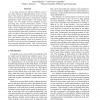Free Online Productivity Tools
i2Speak
i2Symbol
i2OCR
iTex2Img
iWeb2Print
iWeb2Shot
i2Type
iPdf2Split
iPdf2Merge
i2Bopomofo
i2Arabic
i2Style
i2Image
i2PDF
iLatex2Rtf
Sci2ools
170
Voted
CVPR
2012
IEEE
2012
IEEE
The inverted multi-index
A new data structure for efficient similarity search in very large datasets of high-dimensional vectors is introduced. This structure called the inverted multi-index generalizes the inverted index idea by replacing the standard quantization within inverted indices with product quantization. For very similar retrieval complexity and preprocessing time, inverted multi-indices achieve a much denser subdivision of the search space compared to inverted indices, while retaining their memory efficiency. Our experiments with large datasets of SIFT and GIST vectors demonstrate that because of the denser subdivision, inverted multiindices are able to return much shorter candidate lists with higher recall. Augmented with a suitable reranking procedure, multi-indices were able to improve the speed of approximate nearest neighbor search on the dataset of 1 billion SIFT vectors by an order of magnitude compared to the best previously published systems, while achieving better recall and incurring ...
| Added | 28 Sep 2012 |
| Updated | 28 Sep 2012 |
| Type | Journal |
| Year | 2012 |
| Where | CVPR |
| Authors | Artem Babenko, Victor S. Lempitsky |
Comments (0)

